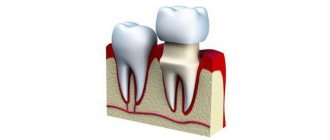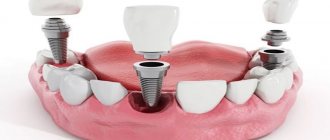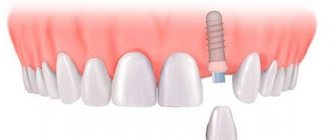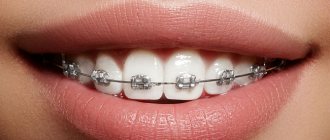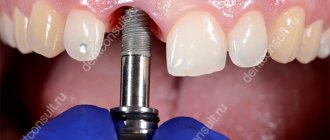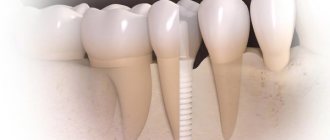1527
Missing one or more teeth can be a real disaster. A person is ready to spend a larger amount of money on his appearance than on improving the health of his body.
Such decisions are completely justified. After all, the absence of teeth leads to the loss of their chewing and aesthetic functions. A dental unit, like any organ in the human body, can be replaced with prosthetics, that is, its lost functionality can be partially restored.
To do this, experts offer many options for resolving the problem. Most often, patients have to choose between a crown and an implant. We will consider which design is better, cheaper and more durable in this article.
What are dental crowns
These are non-removable orthopedic structures that are identical in appearance to a natural tooth and fit onto it like a cap. Installed on heavily damaged units that cannot be sealed.
According to the material they are classified into:
- plastic - temporary structures;
- metal-free - ceramic or zirconium, coated with a thin layer of porcelain mass;
- metal - made of metal alloys, gold or gold-plated;
- metal-ceramic - made of metal coated with ceramics.
Depending on the purpose:
- restorative - used to restore functions and the anatomical shape of a damaged tooth.
- supporting - placed as a support for the bridge.
By type of construction:
- complete - completely replace the destroyed unit;
- equatorial - made of metal, fixed around the tooth in the form of a splint;
- half-crowns - do not overlap the unit of the dental row from the side of the tongue, serve as a support for the bridge;
- telescopic - used for attaching removable dentures, changing the volume and height of the tooth.
- pin - mounted on a pin.
Indications for installation include:
- the coronal part is destroyed by more than 1/2;
- increased abrasion of enamel;
- severe damage caused by pathologies.
If a tooth is missing, the crown replacing it is fixed to adjacent units.
Features, pros, cons of crowns
A crown is a shell that covers a dead tooth and can be attached to adjacent teeth. It can be made of metal, plastic (temporary), ceramics or metal ceramics.
The advantages of crowns include:
- are cheaper than implants;
- easy to install, so there is no rehabilitation period;
- are quickly produced.
The disadvantages of crowns include grinding, fragility, and during their installation, neighboring teeth can be damaged. Also, food can get under the crown, which will lead to bad breath, the patient will not be able to eat solid food, and a dark rim appears on the edges of the gums, so it is noticeable that the tooth is “non-native”.
What is dental implantation
After the implant has healed, a crown is placed on top.
An artificial titanium root is implanted into the jaw bone in place of the removed unit. Implants are installed for single, partial and complete edentia.
Implantation is a surgical operation performed under local or general anesthesia. Therefore, tests, X-rays, and computer modeling are mandatory. If the tooth has been missing for a long time, the doctor needs to drill into the gum to install the rod. However, recently, the implantation of an artificial root increasingly takes place immediately after extraction of the diseased unit.
Types of implants:
- Root - in the form of a cone or cylinder with a thread at the base. Osseointegration occurs most easily when there is sufficient bone; if there is insufficient bone, it is augmented surgically.
- Lamellar - used for narrow jaw bones.
- Lamellar-root - combines the two previous types. Practically not used due to its large size and difficult implantation process.
- Subperiosteal - indicated for thinned bone.
- A mini implant is smaller in size than a traditional one. Designed to stabilize removable dentures.
Comparing the benefits of crowns and implants
Compared to titanium rods, crowns have significantly fewer advantages. Their advantages include:
- speed of production and installation;
- low cost.
Among the advantages of implants:
- Long service life. Artificial roots are resistant to temperature irritants and withstand chewing loads well. In 90% of cases, with good care, they last throughout the patient’s life.
- There is no need to grind adjacent units.
- The bone of the upper and lower jaw does not atrophy.
- High level of aesthetics.
- There are no restrictions on the consumption of solid foods.
- Easy to care for; traditional oral hygiene is sufficient.
- The solidity of the structure, ensured by the abutment (adapter-mount), prevents food particles from getting under the prosthesis.
Features of the implant
This design is made in the form of an artificial root. Only hypoallergenic high-tech materials are used to create it. It is implanted into the hole that is formed after extraction of the dental unit.
Over a certain period of time, the structure adheres to bone tissue. After the device has taken root, a crown or bridge is installed on it (if several such roots have been implanted). In addition, removable products can also be attached to implants.
Positive sides:
- Chewing is not impaired ;
- no discomfort;
- the incisors and adjacent molars are not injured
- no restrictions on products;
- have high wear resistance and strength.
Negative sides:
- contraindications for installation;
- high price;
- long adaptation period;
- the likelihood of rejection .
On this topic
- Crowns
What to do if a tooth has rotted under the crown
- Olga Alexandrovna Novikova
- October 4, 2020
When the implant fuses with bone tissue, an inflammatory process in the tissues surrounding it may develop.
When installing artificial teeth, the following negative consequences are possible:
- unscrewing the implant along with the plug;
- damage to the maxillary sinus when the abutment is installed;
- swelling;
- opening of bleeding;
- formation of hematomas;
- divergence of seams.
Installation of an artificial root is contraindicated if:
- tuberculosis;
- neoplasms of a benign or malignant nature;
- pathologies ;
- mental disorders;
- weakened immune system;
- increased tone of the masticatory structure;
- diabetes mellitus;
- infectious and inflammatory processes occurring in the oral cavity;
- chronic diseases at the acute stage.
The performance characteristics of such structures are significantly higher compared to crowns. Many manufacturers provide a lifetime warranty on the use of the product.
Implants and crowns: what are the disadvantages?
The disadvantages of single dentures include:
- Significant risk of damage to adjacent healthy teeth.
- Fragility of non-metallic structural elements.
- Possibility of complications:
- if the size is incorrectly selected, they rub and provoke the development of inflammation;
- a small gap remains between the gum and the crown, in which food debris can accumulate, causing an unpleasant odor and destruction of the jaw structures;
- allergic reactions to the material from which a single prosthesis is made are possible;
- development of galvanic syndrome - if there are orthopedic structures made of different metals in the mouth, the patient may experience a metallic taste and headaches;
- risk of gum receding, exposure of the dental neck.
- Short service life compared to implants. The crown is fixed on a pulpless tooth, the destruction of which is a matter of time.
- Consumption of solid foods is contraindicated.
Implants also have disadvantages:
- There is a risk of rejection.
- The procedure for implanting a titanium root is more painful than prosthetics (the disadvantage is eliminated by the use of anesthetic drugs).
- Duration of the method. It takes 4-6 months for the rod to fully engraft.
- Risk of complications:
- damage to the mandibular nerve;
- perforation of the maxillary sinus with small bone volume;
- seam divergence;
- development of inflammation and infection.
- The need for long visits to the dental clinic.
- When installing several implants, to properly distribute the load, a separate orthopedic structure is placed on each one.
Goals of prosthetics
Based on the advantages, it is better to install an implant. But such products are much more expensive than crowns, regardless of the material from which they are made. When installing conventional crowns, certain rules must be followed, since careless hygiene and eating too hard food can damage the product.
An experienced prosthetist can help you make the right choice of which is better – a bridge or an implant. It is the doctor who, having examined MRI and CT computer images, will suggest an acceptable prosthesis option, taking into account the anatomical features of the jaw structure, bite, and location of the lost tooth (see also: is it possible to do an MRI of the brain with metal crowns installed on the teeth?). After which you need to decide further, choosing between a crown and an implant based on your financial capabilities.
A bridge is placed only when a tooth is completely lost. It is preferable when you need a quick restoration of the jaw, if a beautiful appearance is important or if its function is very impaired. The choice in favor of this type of prosthesis is made if a person cannot tolerate pain or is allergic to local anesthetics.
The dentist gives preference to bridge crowns over implants if there is a narrow bone ridge and the patient does not want to undergo bone grafting, as well as if the patient has increased allergic sensitivity, serious heart and vascular diseases, hormonal disorders, anemia, diabetes and other chronic diseases.
DETAILS: Is it possible to drink alcohol while wearing braces?
If you want reliable and durable dental restoration, then the choice is implantation. When only one tooth is missing, it is better to place implants, because when choosing a bridge, at least two more neighboring teeth are damaged (see also: does it hurt to place an implant and is it worth it?).
Contraindications
Implantation has many contraindications, much more than installing crowns. It is strictly forbidden to implant patients who have suffered a stroke, heart attack, thrombophlebitis, or atherosclerosis. It is impossible to prescribe implant prosthetics for all serious systemic diseases affecting the cardiac, circulatory, and immune systems.
It is difficult to answer the question which is better: a crown, a bridge or an implant; it all depends on the specific situation. There are several factors to consider when choosing the right dental implant procedure:
- Bridges, unlike crowns, cannot be removed. Consequently, the crown is more hygienic, as it can be cleaned.
- Also, a bridge is much cheaper than an implant. However, the bridge must be replaced after 5 years due to wear and tear. There will be no such problems with an implant.
- The crown is in the middle price range between an implant and a bridge.
- Installing an implant does not require the involvement of neighboring teeth in the prosthetic process, whereas when installing a bridge it is impossible to avoid grinding down healthy, nearby teeth. In case of restoration of one tooth or several closely located ones, the installation of an implant is best suited. If the teeth located near the problem area are alive and do not have a filling, then it is better to restore them with the help of implants, since the procedure for depulping teeth can lead to a shortening of their service life.
- When installing a bridge, the load on the jaw bone is disproportionately distributed, which can contribute to partial atrophy of the bone tissue. Bridge prosthetics is most suitable if there is a predominant defect in the supporting teeth.
- However, implantation is inferior to the installation of a bridge in that there may be some risks associated with the possible occurrence of complications during implantation.
We suggest you familiarize yourself with Burning in the mouth and tongue: causes of the sensation as if burned, treatment, treatment of diseases
Indications for installing implants, in addition to dental problems, are:
- The patient does not agree to grind down adjacent specimens.
- It is not possible to make a bridge.
- The patient does not agree to the installation of a bridge.
Crowns are installed in the following cases:
- Complete destruction of the enamel.
- Destruction of the crown part of the tooth due to disease.
- Significant abrasion.
But there are a large number of contraindications to the installation of these structures.
The main absolute contraindications include:
- Oncological diseases.
- Diabetes.
- Blood diseases.
- Tuberculosis.
- Nervous and mental disorders.
- Diseases of the oral mucosa.
- Reduced immunity.
- Tone of the masticatory muscles.
- Exacerbation of chronic diseases.
- Inadequate oral care.
When installing implants, the amount of bone tissue and its condition are taken into account.
Which method is better?
If the adjacent teeth are intact, a bridge can be placed on them. Then it will last for a long time.
But the patient must understand that the supporting teeth are not durable, so over time this bridge will have to be reinstalled. In addition, depending on the load, the structure may become loose.
In the case when several teeth in a row have lost the ability to perform their functions, for example, one is crumbling, the second has a damaged root, the third has suffered too much from caries, in this case it is better to install several implants.
They will preserve the width of the bone tissue and restore chewing functions.
| Durability | Difficulty of care | Function restoration | Appearance | |
| Combined crowns | according to WHO 7-8 years | They do not require special care; it is recommended to rinse your mouth after eating and clean with regular pastes. | Do not overload artificial structures: open lids, crack nuts, chew bones | Perfectly matched in color, practically indistinguishable from natural teeth |
| Implants | from 15 to 25 years when using high-quality titanium | They do not require special care, it is important to prevent the growth of pathogenic bacteria | Functions are restored to 100% | Cannot be distinguished from natural |
The main misconception of many patients in dental clinics is that they consider the main task of the prosthesis to be an aesthetic function. But, in fact, in addition to a beautiful smile, prosthetics are also necessary for human health.
Here are the main reasons why you should agree to such a procedure, even if the lost teeth do not affect the aesthetics of your smile:
- Removing even one tooth weakens the entire row - the chewing load is distributed to the remaining elements, and they are more susceptible to wear. Prosthetics solve this problem, and the chewing load is better distributed.
- As a result of tooth loss, the bite is disrupted and the risk of plaque and caries increases.
- In the absence of some teeth, chewing food becomes poor quality, as a result of which the digestive system suffers - diseases of the stomach, pancreas, and gall bladder begin to appear. You may become overweight.
- Inaction may provoke future loss of remaining dental units.
What is better to choose - an implant or another type of prosthesis, this issue is decided separately for each patient, because it is important to take into account the individual characteristics and condition of the jaw. What is best for one patient may be unacceptable for another due to contraindications.
The only thing that is important to understand is that it is impossible to maintain the health of the oral cavity and other organs without timely restoration of the dentition.
Knowing all the advantages and disadvantages of these types of prosthetics, you have to make an important decision - which one to choose, because artificial structures are installed for more than one year?
The specialist approaches each case individually, determining the possibility of surgical intervention and crown installation.
Which method is better?
What is better to install: crowns or implants, many people take a long time to decide. In this matter, you need to weigh the pros and cons.
The installation of crowns is justified if the patient does not have the opportunity to install an implant, the adjacent teeth next to the affected one are intact, or there are direct contraindications to implantation.
| Durability | Difficulty of care | Function restoration | Appearance | |
| Combined crowns | according to WHO 7-8 years | They do not require special care; it is recommended to rinse your mouth after eating and clean with regular pastes. | Do not overload artificial structures: open lids, crack nuts, chew bones | Perfectly matched in color, practically indistinguishable from natural teeth |
| Implants | from 15 to 25 years when using high-quality titanium | They do not require special care, it is important to prevent the growth of pathogenic bacteria | Functions are restored to 100% | Cannot be distinguished from natural |
How to make a choice
Before choosing the type of prosthetics, consultation with a specialist is necessary.
To choose the type of prosthetics - implants or traditional - you need to assess the condition of the oral cavity. The doctor examines the shape of the jaws, the amount and condition of bone tissue, and the location of the mandibular nerve. For this purpose, computed tomography and orthopantomogram are used.
If the patient is inclined towards implantation, it is necessary to undergo a full examination. You should opt for implantation when:
- it is necessary to restore one or more teeth in a row;
- a destroyed tooth is adjacent to healthy teeth, since after removing the nerves under the crowns, they will collapse faster.
When choosing a crown, first of all, the supporting teeth are assessed (the possibility of not having to remove nerves, the quality of canal filling if the tooth is pulpless). It is recommended to install a crown when the supporting teeth have already been filled or damaged.
